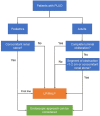Minimal Invasive Treatment in Pelvic-Ureteric Junction Obstruction: A Comprehensive Review
- PMID: 34408990
- PMCID: PMC8364382
- DOI: 10.2147/RRU.S268569
Minimal Invasive Treatment in Pelvic-Ureteric Junction Obstruction: A Comprehensive Review
Abstract
Pelvic-ureteric junction obstruction (PUJO) is a common condition, and one of the lead causes of hydronephrosis in children. Currently, the gold standard treatment of PUJO is open surgery using the Anderson-Hynes-modified dismembered pyeloplasty technique. However, with the advancement of medical technology, several minimal invasive approaches were developed, including endoscopic, laparoscopic, and robotic approach, from which the best choice of surgical technique was yet to be determined. Considering the advantages and disadvantages of these methods, the recommended option is to tailor the best surgical approach to each individual patient, and to the surgeons' preference and experience. Considering these recent advances, a new algorithm is proposed to choose the best minimal invasive modalities invasive treatment to treat PUJO.
Keywords: Anderson–Hynes dismembered pyeloplasty; PUJO; hydronephrosis; minimal invasive.
© 2021 Wahyudi et al.
Conflict of interest statement
The authors declare that there is no conflict of interest to disclose.
Figures
References
-
- Radmayr C, Bogaert G, Dogan HS, et al. EAU Guidelines on Paediatric Urology. The Netherlands: EAU Guidelines Office; 2020.
Publication types
LinkOut - more resources
Full Text Sources



